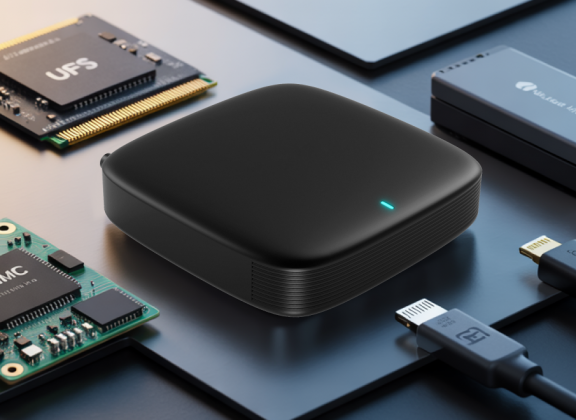When choosing a media player, most people focus on features like processor power, streaming capabilities, or resolution support. Yet storage technology has just as much influence on your experience. The type of storage determines how quickly your device boots, how fast it opens apps, and how reliably it streams or plays large files from local sources. The most common options you will encounter are eMMC, UFS, and external SSDs. Each serves a purpose, but their differences in speed, capacity, and flexibility mean one may suit your needs far better than the others.
eMMC: Proven and Affordable
Embedded MultiMediaCard storage has been a mainstay in consumer electronics for years. It combines flash memory and a controller in a compact package, making it easy to integrate into small devices like media players. eMMC offers predictable performance and enough bandwidth for general media playback and typical streaming tasks.
However, eMMC’s parallel interface and limited read/write throughput mean it can feel slow compared to newer storage formats. While it is more than adequate for Full HD playback or lightweight apps, users working with large 4K video files or multitasking between several applications may notice lag. Over years of heavy use, write performance can degrade slightly, affecting load times. Still, for cost-conscious buyers, eMMC remains a practical and reliable choice, especially in devices focused on basic streaming and media viewing.
UFS: A Modern Speed Upgrade
Universal Flash Storage was designed to address the speed and efficiency limits of eMMC. Using a serial interface and full-duplex transfer, UFS allows data to be read and written at the same time, reducing bottlenecks and improving overall responsiveness. In a media player, this translates into quicker navigation, faster loading of large local files, and smoother playback of high-resolution video.
Because UFS also delivers lower latency and better energy efficiency, devices equipped with it tend to stay cooler and respond faster to user actions. This makes UFS especially appealing for those who demand a fluid, high-performance interface and frequent use of locally stored UHD content. The only trade-off is cost—UFS adds to the device’s manufacturing expense, making it more common in mid-range and premium models.
External SSD: Maximum Capacity and Versatility
For users who require both speed and massive storage, an external Solid State Drive can be a game-changer. Connected via high-speed USB (preferably USB 3.0 or above), an SSD can reach read/write speeds that rival or exceed even advanced internal UFS modules, particularly if the drive is NVMe-based. This level of performance is ideal for large video archives, uncompressed 4K or 8K files, and other demanding media formats.
Another advantage is portability: an external SSD can easily be swapped between devices or upgraded without replacing your media player. It also provides a convenient way to back up or expand your media library. The main limitation is that not all media players can take full advantage of an SSD’s speed due to interface constraints. Furthermore, core system performance will still depend on the device’s internal storage, meaning the SSD’s benefit is most noticeable when accessing large media files rather than improving the operating system’s responsiveness.
Making the Right Choice
Selecting between eMMC, UFS, and an external SSD depends on your viewing habits and technical requirements. For primarily streaming-focused use, where internet bandwidth is the limiting factor, eMMC is often sufficient. If you want a faster, more responsive interface and quick access to high-resolution local content, UFS provides a noticeable boost. When storage size and raw transfer speeds are the top priorities—especially for very large offline collections—an external SSD offers unmatched flexibility.
In the end, the right decision balances budget, speed, and storage capacity. UFS delivers premium in-device performance, external SSDs excel in scalability and speed, and eMMC holds its ground as a budget-friendly, dependable option. Matching the storage type to your actual usage ensures your media player runs smoothly and keeps pace with your entertainment needs.
